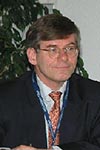Day 1 :
Keynote Forum
M Khalid Ijaz
RB, USA
Keynote: From Ebola what’s next - Hierarchy of microbicide resistance as a predictor of activity against emerging viruses
Time : 09:05-09:30

Biography:
M Khalid Ijaz received DVM, MSc (Honours) from University of Agriculture, Faisalabad, Pakistan and completed Ph.D. in Microbiology and Immunology in 1985 at University of Ottawa, Canada. He did his post-doctoral work at the Vaccines and Infectious Disease Organization (VIDO), Canada. Currently, he’s Research Fellow at RB, Montvale, N.J. and Adjunct Associate Professor at The City University of New York (CUNY). His research focuses on human pathogenic microbial agents’ spread via the environment and mitigational role of hygiene agents. He is an active member of various scientific organizations including American for Microbiology, American Society for Virology, ASTM-International, Association of Professional for Infection Control and Epidemiology and International Society for Infectious Diseases.
Abstract:
A combination of factors has caused an upsurge in the emergence of infectious agents in the past few decades, with viruses representing nearly 67% of those recognized between 1980-2014; prominent among the newly discovered ones are the causes of AIDS, hepatitis C, pandemic influenza, Ebola virus and severe respiratory infections (e.g., SARS, Nipah, Hendra, MERS). Predictive modelling suggests that by 2020 another 10-40 new viruses will be discovered. Although vaccination, antiviral chemotherapy, control of insect vectors, screening of blood/tissues, and the use of barriers such as condoms can effectively interrupt virus dissemination, the use of microbicidal chemicals for environmental decontamination and hand hygiene in both domestic and institutional settings remains an essential preventive strategy to safe-guard public health. Consequently, national and international agencies including WHO emphasize the use of appropriate environmental surface disinfectants and antiseptics, in conjunction with proper hand hygiene, as essential and generic components of preventive strategies against viruses as well as other types of infectious agents. While most regulatory agencies normally register environmental surface disinfectants for sale based on testing against surrogate microbial agents, the U.S. Environmental Protection Agency (EPA) requires test data against each virus to be listed on product labels. Such a system makes selection of disinfectants difficult against emerging viruses. To address this, an interim guidance system against emerging viruses has been developed based on the known hierarchy of resistance/susceptibility of existing human pathogenic viruses to environmental surface disinfectants. This presentation will summarize this predictive approach and its applications to Ebola and other newly discovered viruses.
Keynote Forum
Guido Norbiato
University Hospital Luigi Sacco, Italy
Keynote: New biological treatment of HIV infection and AIDS-related diseases
Time : 09:30-09:55

Biography:
Guido Norbiato has completed his MD at the age of 25 years from University of Studies in Milan-Italy. Postdoctoral studies, Specialty of Endocrinology and Metabolism, Qualification for University teaching, Assistant professor from the University of Studies of Milan. He moved to L. Sacco University Hospital of Milan where he became Chief of the Endocrinology and Metabolism unit and founded the Laboratory of endocrinology, after he became Director of the Department of Specialistic Diseases. He published more than 140 articles and publications in internationally referred journals regarding endocrinology, metabolism, and autonomic, immune, inflammatory, vascular systems. With impact factor 600, he edited two books on endocrinology and metabolism in HIV infection.
Abstract:
AIDS-related illnesses are no longer the primary threat, but a new set of HIV-associated complications has emerged resulting in a novel chronic disease that for many HIV-infected people will span several decades of life. Deterioration of crucial homeostatic mechanisms in such disease invariably results in activation of inflammatory mediators, chronic inflammation, cellular aging, loss in immunological function, increased susceptibility to diseases, alteration of metabolism, decrease of energy production and neuro-cognitive decline. Owing the complexity of the systems involved in such disease, substantial limitation of current therapeutic approach persists. We propose here a treatment with stem cells differentiation stage factors taken from zebrafish embryos which are able to regulate in different, specific way the genes expression of normal and pathological stem cells. Exposure to early developmental stage of zebrafish embryo growth and differentiation factors may enhance stem cell expression of multipotency and activate both telomerase-dependent and -independent antagonists of cell senescence. Factors taken from late stages of cell differentiation can be used to control cell proliferation of tumor cells. All factor networks are able to prevent neuro-degeneration and other degenerative phenomena present in chronic diseases and to maintain the homeostasis of neuro-endocrine-immune- metabolic mechanisms disrupted by stress and other threatening situation . Our research aims to provide novel insight regarding the potential combination of epigenetic reprogramming mechanisms in controlling plasticity and pluripotencies of stem cells population and define stem cells differentiation factors capable in repairing different pathological stem cells which are at the origin of many chronic diseases.
Keynote Forum
Stef Stienstra
Dutch Armed Forces/Royal Dutch Navy, Netherlands
Keynote: The threat of zoonotic diseases and Ebola virus disease specifically
Time : 09:55-10:30

Biography:
Stef Stienstra is a Strategic and creative consultant in biomedical science, with a parallel career as a Commander of the reserve of the Royal Dutch Navy. For the Dutch Armed Forces he has responsibility for the counter measures in CBNRe threats and (medical) consequence management both in a military and a civilian (terrorism) setting. He is strategic functional specialist for “Health & Environment” of the 1-Civil-Military-Interaction Command (1-CMI) of the Dutch Armed Forces and for 2015 also in the NATO Response Force (NRF), which is in 2015 the responsibility of the 1-German-Netherlands-Corps (1-GNC). He was the director of the 2014 World Congress of CBRNe Science & Consequence Management in Tbilisi, Georgia. In his civil career he works internationally as consultant or as scientific supervisory board member for several medical and biotech companies, merely involved in biodefense. He is also visiting professor for Punjab University in Pakistan and Rhein-Waal University in Germany. He has finished his studies in Medicine and in Biochemistry at the University of Groningen in The Netherlands and has extensive practical experience in cell biology, immuno-haematology, biodefense and transfusion medicine. His natural business acumen and negotiation competence helps to initiate new successful businesses, often created out of unexpected combinations of technologies. His good understanding of abstract science combined with excellent skills in the communication of scientific matters to non-specialists, helps him with strategic consulting at top level management.
Abstract:
Public health systems are not always prepared for huge outbreaks of infectious diseases. Although the in the past several public health institutes were prominent surveyors of infectious diseases and very active in the mitigation of infectious diseases both in- and outside their country of origin, like the French Institute Pasteur, Dutch Tropeninstituut and many others Institutes, the investments in worldwide public health was in the last decennia far less compared to curative healthcare. With the recent Ebola Virus Disease outbreak in West Africa we see now a new wave of growing interest in Worldwide Public Health. Zoonotic diseases are the most dangerous for outbreaks as the population does not have natural nor artificial (from vaccination) immune response to new emerging diseases. The Ebola Virus Disease outbreak in West Africa is such an example. As the new strain of the Ebola Virus in West Africa has a longer incubation time and is only slightly less lethal compared other Ebola Virus strains, the threat of spreading among the population is far bigger. Especially when the epidemic enters denser populated areas. The mitigation of a highly infectious and deadly disease outbreak has several aspects for which most public health systems in the world are not trained well enough. NGO’s helping to fight the outbreak are often also better trained in curative treatments and have less experience with biological (bioweapon) threats for which the military are trained for. The UNMEER mission is unique in this. It is a setting in which military and civilian actors cooperate in fighting a biological threat. Protection is essential for health workers and smart systems have to be developed to prevent further spreading of the disease. But it is unfortunately not only the biosafety, which has to be considered, but also the biosecurity, as misuse of extremely dangerous strains of microorganisms cannot be excluded. Several zoonotic infectious diseases, like anthrax, small pox and also the haemorrhagic fevers like Ebola Virus Disease are listed as potential bioweapons. With this extra threat in mind both biosafety and biosecurity has to be implemented in all measures to fight outbreaks of highly infectious diseases, as we are now doing in West Africa.
